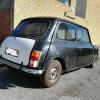Allright, so for once, this post is not about a problem, but rather a tip to do something for a change.
So the story is as follows: I wanted to install an oil pressure sensor in my mini. the main reason is that it seems to be the way most of mini engine die, because when the pressure light finally flashes on the tiny dashboard, well, the damage is already done, so I wanted to monitor a bit closely what the pressure is.
plus it gives me also an indirect sense of "engine readiness" as I know the pressure drops a bit when the engine is at the right temperature. Sure enough, I could also install an oil temperature sensor but my dash has 3 instruments and I wanted a clock and a volt meter, so here we go.
Because installing just an oil sensor would be too easy, I have put the following constraints:
- it has to be electrical and not the one with the oil pick-up. 2 reasons for that: I don't want oil in my cabin. and I'm an electronic engineer by day, so I tend to go for a solution that involves electrons rather than nasty fluids running pipes.
- it has to fit in the engine bay without too much plumbing.
We mini people tend to go for solutions we know. so for instance, my first solution was: look in forums, get the classic "T" piece and install the Smiths electrical sender unit where the oil pressure contact normally sits in the engine bay (top right corner of the engine block front face). the "T" look like this:
 IMG_20190615_114127-W600.jpg 11.7K
12 downloads
IMG_20190615_114127-W600.jpg 11.7K
12 downloads
it has conical 1/8NPT thread so you could in theory fit the oil pressure sender unit and the existing pressure light switch.
Well, in theory. because in practice the Smiths electrical sender unit is as big as a whisky barrel and it would not fit there quite nicely. I have asked around and 2 suggestions came:
A nice mini racing company suggested to fit an oil line on the block, then the T piece and then the units. and try to keep the hose in place. Why not, but I did not like the multiplication of connectors. plus the sender unit is not only has big as a barrel, but it has about the same weight and I did not like the idea of having it dandling there. So no.
Another guy suggested to move the distributor, at which point I faded into oblivion. seemed like a lot of work to just get an oil pressure unit.
So both solutions were out of the question. So I have been looking around. Most racing people are familiar with oil filter sandwich plate when it comes to installing an oil cooler. Turns out there are also sandwich plates with 1/8NPT for sensors.
I got mine from Mishimoto (which turns out to be an american company). but there are many vendors out there including some Amazon stuffs although I let you judge of their credibility. here is how it looks like:
 IMG_20190604_202001-W600.jpg 34.52K
20 downloads
IMG_20190604_202001-W600.jpg 34.52K
20 downloads
It is an anodized aluminium. this one a 3 sensor ports, and it fits between the oil filter head and the oil filter. it has a rubber gasket on top, like an oil filter, and comes with a screw that correspond to the oil filter thread: you put it in place, you screw it and then it acts as your oil filter head.
Several reasons to go for such solution at least for me:
If I mess it up somehow, I have to replace my filter head, which is quite affordable.
if I mess up the block while fiddling with the oil pressure contact switch port, boy am I in trouble!
So it seemed like a good idea to proceed like that. As I was installing an MED filter head anyway, I could make a dry assembly on my desk to see if everything fit together:
 IMG_20190604_204804_296-W600.jpg 21.16K
27 downloads
IMG_20190604_204804_296-W600.jpg 21.16K
27 downloads
then you can bolt in the whole unit and attach your electrical sender unit to it and voilà:
 IMG_20190613_203741-W600.jpg 42.26K
24 downloads
IMG_20190613_203741-W600.jpg 42.26K
24 downloads
It is a good solution, to my humble opinion because:
it fits!
it has no clearance issue
it does not mess with the block in the end.
it gives me 2 extra ports to fit, say an oil temperature and/or a pressure safety switch for an electrical fuel pump eventually. so it's quite future proof.
you don't need the MED head to work of course, you could use your existing head, it's just since I was in that process anyway.
Finally, some more tips if you want to do the same:
some of those sandwich plates come with the port blocking screw quite loosely attached. don't forget to tighten those, even if you don't use them. otherwise it will drip oil slowly but surely.
don't over-tighten those screws and units! don't forget it's juste aluminium and not your average Sherman Tank armor plate you are screwing this in. it will eventually deform and leak if you do.
as with conical threads you need to add PTFE tape (we call it Teflon tape where I am, for some reason) on the thread to ensure it sealed. one of the consequence is that it will insulate electrically the sensor head so, before installing the sender unit, I have added an electrical washer on the thread with a spring washer for good measure. then I ran a cable to the nearest body ground and that works.
Besides, even if you would not add PTFE, anodized aluminium is not the best conductor, and on top of that there is a rubber seal between the sandwich plate and the filter head, which turned out to be anodized as well, so better safe than sorry, use a grounded washer. ![]()
the other connector on the smiths sender unit goes back in the cabin to connect to the electrical fuel gauge. For additionnal safety, I added a fuse on that line (well basically I added a fuse box just for all the extra instruments to be on the safe side but that's another story I'll tell later ![]() )
)
hope this helps, if you want to fit an oil filter unit one day. sure it would have helped me.
And as with any engine modification, please keep it safe, check for oil level, pressure and leaks before hitting the road!
cheers guys !
Edited by Benoit_Dupont, 09 August 2019 - 12:19 PM.


















